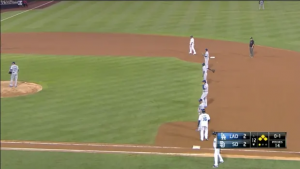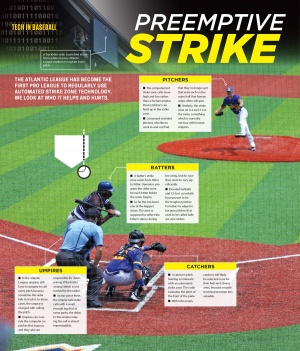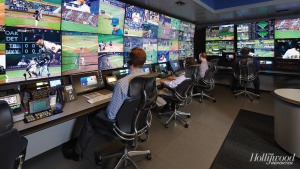Major League Baseball
Statistics are one of the oldest, most common ways to evaluate baseball teams and players. Statistics such as batting average, runs batted in, and e earned run average are all used to evaluate players.[1] Cheating has long been a part of baseball, but with the introduction of new technologies it has become easier than ever.[2] The use of new technology is continuing to grow due to its usefulness and ability to counteract previous failures in the game, such as the stealing of signs. It has also caused a shift in how the game is played. The biggest question that many managers, players, and fans are asking today is whether technology is helping or hurting the integrity of the game.
Contents
The Question of Technology in Baseball
Some blame technology for the recent cheating scandals in baseball, claiming it has no place in the game, while others fight for the implementation of new technologies in order to protect the honesty and accuracy of the game. The fight for statistics and technology peaked after the Oakland Athletics’ manager, Billy Beane, released his winning strategy book “ Moneyball”. In the book, he explains how he used statistics and analytics to create a roster that shifted the odds of winning baseball games.[3] Other teams, such as the Tampa Bay Rays, have adopted this style of management to reduce the amount of money spent on players while increasing the number of wins.[4] Another consequence of statistical analysis used by teams is "the shift". The shift is when a team, using the statistics about where the current batter is most likely to hit the ball, has its players on the field move to new positions to increase their chance of getting the batter out.[5]

Many long-time fans of baseball see this new style of play as detrimental to baseball, as it has decreased the number of baseballs that are put in play. The Houston Astros sign-stealing scandal which occurred during the 2017 season and World Series Championship, has caused many managers and fans to fight for complete removal of technology from baseball in order to take power away from “technocrats” and return to the original ways of baseball. The MLB is now investigating how to address both sides of the argument, to use technology to improve the game, but also keep the integrity of baseball.
Arguments For New Technology in Baseball
No matter what angle you approach baseball from, statistics are a key component in the creation of lineups, player development, and the comparison of players and teams. The use of technology to generate these statistics is inevitable. Another key way technology has been implemented in recent years is with the insertion of the manager challenge rule. Upon a manager challenge, the MLB allows video replays for calls such as out and safe, or whether a ball is caught or not. However, reviewing ball and strike calls is not an option. People who embrace technology in the MLB are advocating for a more robotic umpire to improve the accuracy of such ball and strike calls. Leagues such as the Atlantic League are testing this option by using Trackman, a radar-based system that can identify if a pitch is in the strike zone or not — at the same speed that a human umpire can. This “3-D Doppler radar dish” analyzes thrown pitches using a three-dimensional strike zone that can calculate each batter's size and stance and adjust the strike zone accordingly. The system self-adjusts to avoid a 6-foot-7 player and a 5-foot-7 player having the same strike zone.[7] The ball or strike call from Trackman is then transmitted to the human umpire behind the plate through an earpiece, who verbalizes the call. Many fear this takes away the human aspect of the game, but from its testing in the American League, players, umpires, and coaches tend to like the new application.
Against New Technology in Baseball
More new technology is beginning to enter the game to counteract the multiple cheating scandals in the MLB over the past five years. Notably, the Houston Astros 2017 World Series Championship. Although many of the players involved in this scandal claim they did not wear buzzers under their jerseys in the 2017 regular or post-season games, there has been an in-depth investigation into how the Astros stole the signs and signals of other teams and alerted their batters on what pitches to expect. A sign is how a catcher and pitcher communicate about what pitch is coming next. This allows the catcher to set up his position to make sure he catches the ball. Stealing signs and signals is not illegal, in fact, many see it as a fun part of the game. However, using technology to steal signs is highly illegal, which is what the Astros did.[8] When on second base, players will often try to steal signs, as they can see the opposing team's catcher. While that is allowed, the Astros used a video replay stream from center field and sent it to a television monitor behind their dugout. Then, Astros players would bang on a trashcan with a bat to alert the batter to expect a curveball or changeup. If players didn't bang on the trashcan, the batters expected a fastball. This implementation of technology led to the Astros to win the World Series in an unethical way. The Astros scandal caused an abundance of uproar, especially after similar scandals with less media attention have been uncovered, such as the Boston Red Sox using Apple Watches to steal pitches by communicating with people outside the dugout.
Ethics of the Code of Silence
After the Astros scandal came to light, there were no severe punishments given to the Astros players by the MLB commissioner. The MLB suspended the Astros general manager and manager for one year and fined the team $5 million. The team also won $31 million in bonuses for winning the World Series due to the scandal so all in all, the rewards still outweighed the consequences. Due to this, protestors of technology in baseball believe that the MLB has problems with their code of ethics ingrained within its culture and that the game could suffer unless something changes.[9] Mike Fiers, the Astros' pitcher, spoke up about the Astros' sign-stealing scheme, and has suffered consequences for doing so. Most likely, all Astros players, managers, and operations staff knew about the scam, but no one else spoke up to break the MLB's code of silence. The code of silence exists because few people within the MLB actually play by the rules. The code of silence has been used for years, through the steroids era, and now when technology is used to cheat. Players do not report wrongdoings mostly because of fear that doing so would result in threats from players, MLB staff, and fans. Because of this, people continue to look the other way, raising serious ethical concerns. There is not a lot of benefit to breaking the code of silence either, because the MLB has not been known to hold unethical behavior accountable.[9] Furthermore, in recent years, there has been a decline in ethical behavior and an acceleration of improper conduct.[10] Due to this, after the Astros scandal, the MLB began to discuss how to limit player access to live video during games so that they cannot steal signs and signals using technology. Those against the use of technology in baseball suggested banning live video during games entirely, which is not likely to happen.[11]
The Future of Tech in Baseball and Protecting Against Cheating
With the increase in the use of technology in baseball, keeping tabs on cheating has become more difficult [12]. After many recent cheating scandals, MLB commissioner, Rob Manfred, stated that new protocols will be put in place to prevent further cheating [13]. Additionally, the MLB admitted that it has become increasingly difficult to monitor the possible inappropriate use of technology [12]. During an interview with Sports Illustrated, Manfred suggested that he "has considered not making video rooms available to teams once games start. The only monitor available to a team could be a replay screen with an MLB security official standing next to it” [13]. There was a policy to have an official in the replay room that was formally placed into effect during the 2018 post-season [12]. Now, this policy has been made stricter with limited access to the replay room, while still having someone in the room to monitor behavior [13][12]. Additionally, general managers now have to sign a document that states that their teams do not knowingly cheat [12]. Manfred is also currently debating if it is better to add more technology to try to prevent cheating or reduce the amount of technology used in the game altogether [13]. There are no long-term solutions yet, but in the interim, the commissioner’s solution is to regulate teams more closely to make sure all the teams are playing according to the rules [13].
The biggest debate now is whether the implementation of technology will reverse or enhance these cheating trends. Teams and leagues are testing new ways for pitchers and catchers to communicate rather than using old-fashioned signs and signals in hopes of reducing the ability of teams to steal signs. Two of the most prominent methods are an earpiece worn by the pitcher and catcher that allows them to communicate without a mound visit, and a lighting system on the pitcher's mound that is controlled by the catcher. In the lighting system, the catcher presses a button that activates lights on the pitcher's mound, which are only visible to the pitcher. The lights are coordinated with different pitch calls, allowing for a more private exchange of information between the pitcher and catcher. Another example is a wearable device that allows signs sent by the catcher to be encrypted, so it is almost impossible to decode the signs and signals.[14] Companies such as Apple and Fitbit are looking to bid to become the official wearable technology brand for the MLB in order to prevent sign-stealing.[15] Currently these are all not allowed but could help prevent teams from cheating.
A partial model to these technological solutions is already in place and being tested in the NCAA’s Southeastern Conference [16]. Teams are using electronic communication between coaches and catchers which allows the coach to talk strategy with the catcher through an earpiece [16]. The use of earpieces and electronic communication is a form of fighting cheating through technology by adding more technology. The earpieces have been effective in college sports, but minor league pitchers tested earpiece prototypes and found them distracting and uncomfortable to use while playing in a game or practicing [17].
These technologies bring up many ethical questions and concerns from the baseball community. With new technologies come new ways to cheat. How soon before teams hire their own hacking professional to steal signs from earpieces or change the signs sent to the pitcher mid-encryption? Until this technology is tested and implemented in more games, many questions will not be answered, such as how the pace of the game will be affected, the loss of human interaction, and coaches' implementation in games. There will always be a place for technology in baseball, but it has to be used ethically. People advocating for complete technology blackouts are most likely never going to see that happen because technology is taking over all aspects of the world. America’s pastime is being threatened by technology the same way it was by steroids, it won’t kill the sport but it could cause a weakening of the fanbase.
References
- ↑ Standard Stats MLB
- ↑ Kuenster, Robert (26 June 2020). "Cheating Has A Long History In MLB, But Tech-Assisted Sign-Stealing Crosses A Line" Forbes
- ↑ Boylan, Mike (3 October 2017). “‘Moneyball’ and the Oakland A's: How Has It Been so Misunderstood?” Bleacher Report
- ↑ Rogers, Martin (10 October 2019). The Tampa Bay Rays are the undisputed kings of Moneyball Fox Sports
- ↑ Snyder, Matt (3 September 2020). Why it's time for Major League Baseball to ban the shiftCBS Sports.com
- ↑ Baccellieri, Emma (25 July 2018). Proposing a Shift Ban Is Easy, but How Would MLB Implement One Sports Illustrated
- ↑ Acquavella, Katherine (27 August 2019)“Robot Umpires: How It Works and Its Effect on Players and Managers in the Atlantic League, plus What's to Come.” CBSSports.com
- ↑ Longman, Jeré (18 January 2020). “Technology Throws a Curveball to a Sport Built on Deceit. Or Is It Gamesmanship?” The New York Times
- ↑ 9.0 9.1 Miles, John R., and Kira Gochuico (13 March 2020). “Major League Problem – From Code of Silence to Code of Ethics.” Bold Business
- ↑ Kastel, Matthew, and Jordan Kobritz (24 April 2015). "What Baseball Can Teach Us About Ethics" Complianceandethics.org
- ↑ Abraham, Peter (25 February 2020). “Technology's Effect on Baseball Is a Huge Concern for MLBPA Head Tony Clark - The Boston Globe.” BostonGlobe.com, The Boston Globe
- ↑ 12.0 12.1 12.2 12.3 12.4 Wagner, James (24 February 2020). Can Players’ Bosses Control Cheating in Baseball? ‘It’s Tough’. The New York Times
- ↑ 13.0 13.1 13.2 13.3 13.4 West, Jenna (13 January 2020). Rob Manfred: MLB 'Absolutely' Will Implement New Protocols by Opening Day to Prevent Cheating. Sports Illustrated
- ↑ Axisa, Mike (6 January 2020), “MLB Exploring Ways to Use on-Field Technology to Help Prevent Sign-Stealing, Report Says.” CBSSports.com
- ↑ Vigdor, Neil (14 January 2020) “The Houston Astros' Cheating Scandal: Sign-Stealing, Buzzer Intrigue and Tainted Pennants.” The New York Times, The New York Times
- ↑ 16.0 16.1 Brandt, David (15 January 2020). To stop sign stealing, MLB could fight tech with more tech. The Associated Press
- ↑ Keyser, Hannah (6 January 2020). Sources: MLB discussing on-field technology to prevent sign stealing. Yahoo sports

